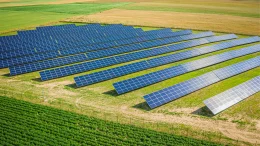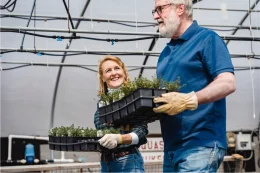
Our 2024 Progress
While our sustainability efforts are constantly evolving, our vision remains consistent — to be the most respected company in our industry and to help create a brighter future for our team members. We take pride in being a trusted part of family meals around the world, and we are dedicated to continually improving our processes to achieve both our global and regional sustainability goals.
On Track
Reduce Scope 1 & 2 GHG emission intensity (per MT of finished product) by 30% by 2030 vs. 2019 baseline
Progress:
23.0% reduction in Scope 1 & 2 GHG emission intensity from 2019 to 2024
On Track
Reduce Scope 1 & 2 GHG emission intensity (per MT of finished product) by 30% by 2030 vs. 2019 baseline
Progress:
23.0% reduction in Scope 1 & 2 GHG emission intensity from 2019 to 2024
On Track
Reduce Scope 1 & 2 GHG emission intensity (per MT of finished product) by 30% by 2030 vs. 2019 baseline
Progress:
23.0% reduction in Scope 1 & 2 GHG emission intensity from 2019 to 2024
On Track
Reach 60% renewable electricity by 2030
Progress:
21.1% of the total electricity used in our global operations was renewable in 2024
On Track
Reach 60% renewable electricity by 2030
Progress:
21.1% of the total electricity used in our global operations was renewable in 2024
On Track
Reach 60% renewable electricity by 2030
Progress:
21.1% of the total electricity used in our global operations was renewable in 2024
Opportunity
Reduce water use intensity by 15% by 2030 vs. 2019 baseline
Progress:
1.3% increase from 2019 to 2024
Opportunity
Reduce water use intensity by 15% by 2030 vs. 2019 baseline
Progress:
1.3% increase from 2019 to 2024
Opportunity
Reduce water use intensity by 15% by 2030 vs. 2019 baseline
Progress:
1.3% increase from 2019 to 2024
On Track
Reduce Scope 1 & 2 GHG emission intensity (per MT of finished product) by 30% by 2030 vs. 2019 baseline
Progress:
23.0% reduction in Scope 1 & 2 GHG emission intensity from 2019 to 2024
On Track
Reduce Scope 1 & 2 GHG emission intensity (per MT of finished product) by 30% by 2030 vs. 2019 baseline
Progress:
23.0% reduction in Scope 1 & 2 GHG emission intensity from 2019 to 2024
On Track
Reduce Scope 1 & 2 GHG emission intensity (per MT of finished product) by 30% by 2030 vs. 2019 baseline
Progress:
23.0% reduction in Scope 1 & 2 GHG emission intensity from 2019 to 2024
On Track
Reach 60% renewable electricity by 2030
Progress:
21.1% of the total electricity used in our global operations was renewable in 2024
On Track
Reach 60% renewable electricity by 2030
Progress:
21.1% of the total electricity used in our global operations was renewable in 2024
On Track
Reach 60% renewable electricity by 2030
Progress:
21.1% of the total electricity used in our global operations was renewable in 2024
Opportunity
Reduce water use intensity by 15% by 2030 vs. 2019 baseline
Progress:
1.3% increase from 2019 to 2024
Opportunity
Reduce water use intensity by 15% by 2030 vs. 2019 baseline
Progress:
1.3% increase from 2019 to 2024
Opportunity
Reduce water use intensity by 15% by 2030 vs. 2019 baseline
Progress:
1.3% increase from 2019 to 2024
On Track
Reduce Scope 1 & 2 GHG emission intensity (per MT of finished product) by 30% by 2030 vs. 2019 baseline
Progress:
23.0% reduction in Scope 1 & 2 GHG emission intensity from 2019 to 2024
On Track
Reduce Scope 1 & 2 GHG emission intensity (per MT of finished product) by 30% by 2030 vs. 2019 baseline
Progress:
23.0% reduction in Scope 1 & 2 GHG emission intensity from 2019 to 2024
On Track
Reduce Scope 1 & 2 GHG emission intensity (per MT of finished product) by 30% by 2030 vs. 2019 baseline
Progress:
23.0% reduction in Scope 1 & 2 GHG emission intensity from 2019 to 2024
On Track
Reach 60% renewable electricity by 2030
Progress:
21.1% of the total electricity used in our global operations was renewable in 2024
On Track
Reach 60% renewable electricity by 2030
Progress:
21.1% of the total electricity used in our global operations was renewable in 2024
On Track
Reach 60% renewable electricity by 2030
Progress:
21.1% of the total electricity used in our global operations was renewable in 2024
Opportunity
Reduce water use intensity by 15% by 2030 vs. 2019 baseline
Progress:
1.3% increase from 2019 to 2024
Opportunity
Reduce water use intensity by 15% by 2030 vs. 2019 baseline
Progress:
1.3% increase from 2019 to 2024
Opportunity
Reduce water use intensity by 15% by 2030 vs. 2019 baseline
Progress:
1.3% increase from 2019 to 2024
* Safety Index = number of severe injuries for every 100 employees ((Severe Injuries*200,000)/Total Hours Worked). Severe Injury = Any injury resulting in amputation, fatality, in-patient hospitalization, vision loss, second- or third-degree burns, or fractures that results in greater than fifteen days lost time, and any other injury that results in greater than fifteen days lost time.
** Depending on the time of receipt, JBS/Pilgrim's Ethics Line cases may not be closed within the same calendar year.
*** Includes concerns about the company’s potential and actual negative impacts on stakeholders. Pilgrim's defines these cases as those related to anti-bribery/anti-corruption (ABAC), antitrust, embezzlement, falsification of corporate documents, financial wrongdoing, theft over US$ 2,000, and conflicts of interest.
When used herein, “net zero by 2040” or “net zero by 2040 goal” shall mean the company’s goal to achieve net-zero greenhouse gas (GHG) emissions by 2040. This goal spans the company’s global operations, as well as its diverse value chain of agricultural producer partners, suppliers and customers, and all other third parties in the company’s value chains. Whether the company is successful in achieving this very ambitious goal will depend on numerous factors outside of the company’s control, including but not limited to: legal and regulatory changes by local governments, technological innovations and infrastructures, energy advancements, economic and environmental conditions, climate change impacts, force majeures, social and cultural factors, international agreements and global trends, financial markets, collaborations and partnerships, and the resources and efforts of those in our value chains. Because of these variables, among others, the company may not be able to achieve net zero by 2040.
Our strategy mirrors our supply chain connections and serves as the overarching framework through which all our sustainability programs and initiatives are developed.

People & Partnerships
The success of our company starts with our people. We focus on providing a safe and well-managed workplace that presents the best opportunities for our team members to thrive. Pilgrim’s also works closely with our value chain and community partners to help build a better food system.
People & Partnerships
The success of our company starts with our people. We focus on providing a safe and well-managed workplace that presents the best opportunities for our team members to thrive. Pilgrim’s also works closely with our value chain and community partners to help build a better food system.
People & Partnerships
The success of our company starts with our people. We focus on providing a safe and well-managed workplace that presents the best opportunities for our team members to thrive. Pilgrim’s also works closely with our value chain and community partners to help build a better food system.

Product Integrity
Animal care and welfare are central to our company culture. Together with our producers and vendors, we focus on the well-being of our poultry and livestock, emphasizing humane treatment at every step. By working with farm partners of all sizes, we strive to offer products that reflect our values of quality and care.
Product Integrity
Animal care and welfare are central to our company culture. Together with our producers and vendors, we focus on the well-being of our poultry and livestock, emphasizing humane treatment at every step. By working with farm partners of all sizes, we strive to offer products that reflect our values of quality and care.
Product Integrity
Animal care and welfare are central to our company culture. Together with our producers and vendors, we focus on the well-being of our poultry and livestock, emphasizing humane treatment at every step. By working with farm partners of all sizes, we strive to offer products that reflect our values of quality and care.
Environment
We work to help society address the challenge of sustainability by operating responsibly, improving the efficiency of our processes, and minimizing our environmental footprint.
Environment
We work to help society address the challenge of sustainability by operating responsibly, improving the efficiency of our processes, and minimizing our environmental footprint.
Environment
We work to help society address the challenge of sustainability by operating responsibly, improving the efficiency of our processes, and minimizing our environmental footprint.
“To feed a growing global population, sustainability is not just a goal—it is a guiding principle embedded in every aspect of our business. We will continue to push boundaries, seek innovative solutions, and strive for meaningful impact in all that we do.”
Our Stories
Our Brands




